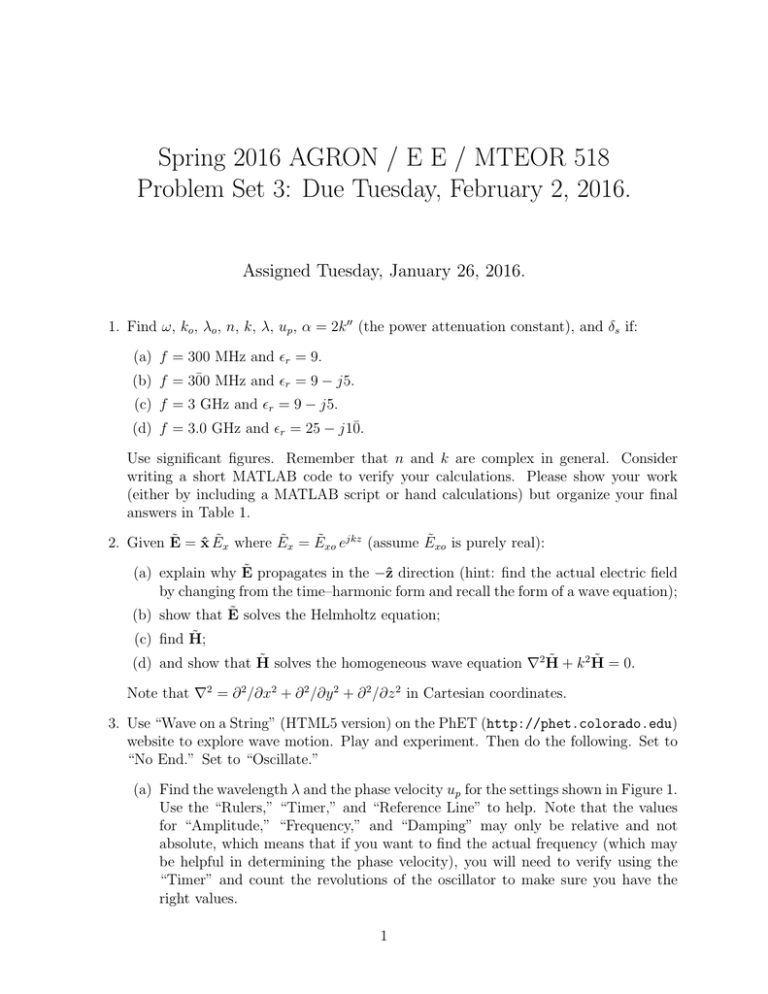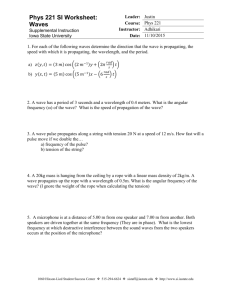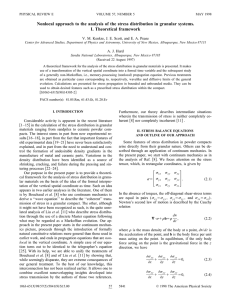Spring 2016 AGRON / E E / MTEOR 518
advertisement

Spring 2016 AGRON / E E / MTEOR 518 Problem Set 3: Due Tuesday, February 2, 2016. Assigned Tuesday, January 26, 2016. 1. Find ω, ko , λo , n, k, λ, up , α = 2k 00 (the power attenuation constant), and δs if: (a) f = 300 MHz and r = 9. (b) f = 30̄0 MHz and r = 9 − j5. (c) f = 3 GHz and r = 9 − j5. (d) f = 3.0 GHz and r = 25 − j10̄. Use significant figures. Remember that n and k are complex in general. Consider writing a short MATLAB code to verify your calculations. Please show your work (either by including a MATLAB script or hand calculations) but organize your final answers in Table 1. 2. Given Ẽ = x̂ Ẽx where Ẽx = Ẽxo ejkz (assume Ẽxo is purely real): (a) explain why Ẽ propagates in the −ẑ direction (hint: find the actual electric field by changing from the time–harmonic form and recall the form of a wave equation); (b) show that Ẽ solves the Helmholtz equation; (c) find H̃; (d) and show that H̃ solves the homogeneous wave equation ∇2 H̃ + k 2 H̃ = 0. Note that ∇2 = ∂ 2 /∂x2 + ∂ 2 /∂y 2 + ∂ 2 /∂z 2 in Cartesian coordinates. 3. Use “Wave on a String” (HTML5 version) on the PhET (http://phet.colorado.edu) website to explore wave motion. Play and experiment. Then do the following. Set to “No End.” Set to “Oscillate.” (a) Find the wavelength λ and the phase velocity up for the settings shown in Figure 1. Use the “Rulers,” “Timer,” and “Reference Line” to help. Note that the values for “Amplitude,” “Frequency,” and “Damping” may only be relative and not absolute, which means that if you want to find the actual frequency (which may be helpful in determining the phase velocity), you will need to verify using the “Timer” and count the revolutions of the oscillator to make sure you have the right values. 1 Figure 1: Settings for part 3a. Figure 2: Settings for question 3d. (b) What material (constitutive) electrical property is analogous to “tension” in the simulation? (c) As “tension” is increased, does this material electrical property increase or decrease? Explain how you determined this. (d) Set to “No End.” Set to “Oscillate.” Use the setting shown in Figure 2. What material electrical property (constitutive property) is analogous to “Damping” in the simulation? 4. Consider the ocean surface to be the x–y plane at z = 0 and that z increases as you travel farther away from the surface, deeper into the ocean. A uniform plane wave is propagating in the +ẑ direction. The constitutive parameters of sea water are r = 82, µr = 1, and the conductivity σ = 6 S m−1 . If the magnetic field at z = 0+ (just inside the ocean, so we are not concerned with surface effects) is π H(z = 0 , t) = ŷ 150 cos 4π × 10 t + mA m−1 9 + 3 (1) (a) find the time harmonic form of the magnetic field, H̃(z), for z > 0; (b) find the time harmonic form of the electric field, Ẽ(z), for z > 0; (c) find the real, time–dependent fields H(z, t) and E(z, t), for z > 0; (d) illustrate how E(z, t) propagates in the ẑ direction by generating a MATLAB figure (consider using the example m–file from the last problem set); (e) determine at what depth the magnitude of the electric field is 5% of its value at z = 0+ . 2 5. Use “Radio Waves” on the PhET website to explore wave motion. Play and experiment. Then answer the following. (a) Even though the radiation propagating away from the radio station antenna is traveling through air (which can be approximated well by free–space), the magnitude of the field decreases. Why? Hint: think about energy conservation, a control volume around the transmitting antenna, and the surface area of this control volume as the control volume gets larger and larger. (b) Considering your answer to 5a, what is one limitation of using a uniform plane wave approximation of a true spherical wave? 6. Read “What Are Climate Models Missing?” with doi:10.1126/science.1237554. (a) Describe what you think is the difference between General Circulation Models, Global Climate Models, and Earth System Models. (b) Distinguish between “convection” and “moist convection.” (c) Distinguish between the “atmosphere” and the “troposphere.” (d) The authors state that There is now ample evidence that an inadequate representation of clouds and moist convection, or more generally the coupling between atmospheric water and circulation, is the main limitation in current representations of the climate system. Name a current remote sensing satellite carrying microwave instruments that is providing observations of the atmosphere which may help correct these shortcomings. (One such satellite was launched by NASA on February 27, 2014.) (e) Given what is shown in the figure in the article, you might have serious doubts about current models of weather and climate. Should we use these models anyway? Why or why not? 3 Table 1: Use this table to organize your answers for Problem 1. ω, rad s−1 ko , rad m−1 λo , m n, — k, rad m−1 4 λ, m up , m s−1 α, Np m−1 δs , m








